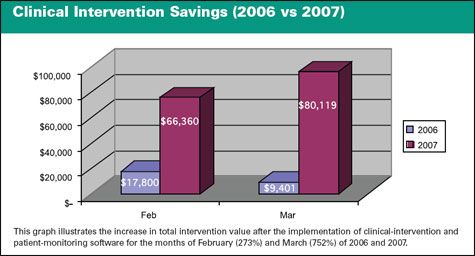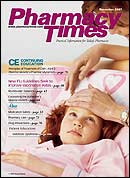Publication
Article
Pharmacy Times
Using Patient-management Software for Improved Care
Author(s):
The pharmacist's role is changing from a technical function.
Dr. Hamby is regional director ofpharmacy at CHRISTUS HospitalSoutheast Texas, Beaumont, Tex.
Experts have estimated thatsomewhere between one thirdand one half of antimicrobialuse in the United States is inappropriate1?a factor that has a negativeimpact on the cost and quality ofhealth care. Pharmacists, physicians,and patients all share the blame, withsome thinking that the medicationwould help and others thinking that atleast it would not hurt. Science hasindicated, however, that widespread,unnecessary use of antibiotics couldindeed complicate care.
With this situation have come effortsto correct inappropriate use. Guidelinesfrom organizations including theInfectious Diseases Society of Americaand the Society for Healthcare Epidemiologyof America provide recommendationsthat range from the simple,such as frequent hand washing, tothe complex, such as compiling localizeddata on microbial resistance.
Health care institutions have takenthese recommendations seriously, oftenimplementing policies or processesthat address these concerns. Theappropriate use of antibiotics or antiinfectivesshould be not just a policybut an expectation. Every hospital inthe country has a responsibility.
This responsibility can be a challengeto manage, requiring the resourcesto collect and analyze datafrom multiple sources, interpret theanalysis into meaningful information,and implement an intelligent policy.These sources include not only patientrelateddata, such as laboratory resultsand medication allergies, but also evidence-based data, such as pharmacologicprofiles.
Software systems that integrate thisinformation can help users in all disciplinesto more easily manage the datarelevant to responsible antibiotic managementand to positively impact care.At CHRISTUS Hospital Southeast Texas,this has been most evident in the pharmaceuticaldepartment, where bothclinical and staff pharmacists haveused electronic data and decision makingto improve care through increasedinterventions.
SHEA Guidelines
Early this year, the Infectious Diseases Society of America and the Societyfor Healthcare Epidemiology of America (SHEA) published guidelines, createdin collaboration with 6 additional associations, to assist institutions indeveloping programs to enhance antimicrobial stewardship. According tothe document, the primary goal of any such program should be to maximizeclinical outcomes while minimizing the unintended consequences of antimicrobialuse, such as toxicity, the selection of pathogenic organisms, and theemergence of resistance.1
Their suggestions include the formation of a multidisciplinary antimicrobialstewardship team with recommended personnel, disciplines, powers,and support. This team may approach stewardship using 1 or 2 suggestedstrategies: prospective audit with intervention and feedback and/or formularyrestriction and preauthorization.
Evidence exists that prospective audit with intervention and feedback byappropriate personnel can decrease the inappropriate use of antimicrobials.1 It also shows that formulary restriction and preauthorization cancause an immediate and significant reduction in antimicrobial use and costduring a nosocomial event, but long-term benefits are not as clear.1
Either or both of these methods should be supported with additionalefforts that include the following:
- Education
- Guidelines and clinical pathways that incorporate evidence-based practicesand local microbiology and resistance patterns
- Antimicrobial order forms
- Streamlining or de-escalation of therapy
- Dose optimization
- Parenteral-to-oral conversion
- Health care information technology, including electronic medical records,computer physician order entry, and clinical decision support
- Computer-based surveillance of antimicrobial interventions, resistancepatterns, nosocomial infections, and adverse drug events
Less certain but also suggested recommendations include antimicrobialcycling and combination therapy. The recommendations can be accessed infull at www.shea-online.org.
The Old and the New
Before the installation of STELLARAClinical Intervention and PatientMonitoring software from bioM?rieuxInc (Durham, NC), pharmacists atCHRISTUS reviewing medication ordershad to go through multiple records,pulling patient laboratory histories andresults as well as medication profiles.The time-consuming process couldmean untimely delivery of the appropriatetherapies. Drug?drug interactionsand adverse events could occur,or the drug assigned might not completelymatch the patient?s infections.
STELLARA alerts users to these conditions,using decision-recommendationtechnology powered by TheraDocExpert System Platform. The integrationof online evidence-based literaturereferences allows clinicians to incorporatethe strongest evidence into theirdaily practices.
The software tool offers flexibility inreporting, allowing users to customizereports and set parameters for workflowmanagement, intervention opportunities,and priorities. CHRISTUS pharmacistshave flags to indicate possibleinterventions, including changes intherapy, agent, or dose.
The Future of Pharmacy Here and Now
Prior to the system?s installation,CHRISTUS pharmacists would writetheir own professional reports to personallydeliver to clinicians. Pharmacistswere reluctant to have this interaction.This information interactionexchange activity, however, will be animportant part of pharmacy in thefuture, especially in institutions.
To bring pharmacists to a level wherethey would be comfortable interveningregularly, I wanted to standardize andautomate the process?which a computerizedprogram would allow. If asystem can pull the information from anumber of different sources into 1place, it can save time.
STELLARA was implemented in astaged rollout, first with clinical pharmacists,who handle departmental responsibilities,and then with staff pharmacists,who work with individualizedpatient reports. These reports, delivereddaily, include recommendations regardingchanges in response to new patientmedications and/or physiology as wellas antibiotic-susceptibility reporting.
Each staff pharmacist is responsiblefor a given patient population that heor she addresses throughout the day.No longer do clinical pharmacists travelthrough the hospital all day.
Armed with the clinically relevantdata and discussion tips, the staff pharmacistshave increased confidenceand increased abilities. The processhas worked.
The hospital has gone from no staffpharmacist interventions to 40 to 60 amonth. In fact, interventions havebecome so prevalent that I intend torewrite job descriptions to includeintervention activity. The role of a pharmacistis changing from a technicalfunction to expertise in informationmanagement and in the interface withother disciplines.
The hospital pharmacists were waryof the new system at first, suspectingthat it would involve more work. Thehospital did want more documentationbut developed innovative ways to createit. Previously, the facility had zerodocumentations from staff pharmacists,but the new system has enableda number of ways to document interventions.Pharmacists can performthese simple tasks themselves or sendorders to the clinical pharmacy departmentfor assistants to log them in.
Assigning a Dollar Value
Prior to the system installation, therewere challenges not only with creatingdocumentation, but also with associatingvalue with pharmacist interventions.
Two years ago, the department usedreports to the pharmacy and therapeuticscommittee to determine that thetotal value of interventions performedon a monthly basis had a modest valueof about $20,000. In recent months,that value has risen to $80,000. Adirect comparison of data fromFebruary and March of 2006 and 2007illustrates the savings further: totalintervention values in February andMarch 2006 were $17,800 and $9,401respectively; in 2007, the numberswere $66,360 and $80,119, respectively(Figure).
The department also has greatlydecreased its expenditures?consistentwith average reports with similar installations.Comprehensive programs haveconsistently demonstrated a decreasein antimicrobial use, by 22% to 36%, withannual savings of $200,000 to $900,000in both larger academic hospitals andsmaller community hospitals.1
By annualizing numbers, the value ofa staff pharmacist can be well-documented.Empowered pharmacists willhave an even easier time performinginterventions, allowing the antimicrobialstewardship program to improvepatient care and be financially self-supporting.The advice pharmacists dispensethen becomes as valuable as themedication.
Figure

Reference
- Dellit TH, Owens RC, McGowan, Jr. JE, et al. Infectious Diseases Society of America and the Society for Healthcare Epidemiology of America guidelines for developing an institutional program to enhance antimicrobial stewardship Clin Infect Dis. 2007;44:159-177. Available at:www.shea-online.org/publications/shea_position_papers.cfm. Accessed April 25, 2007.







